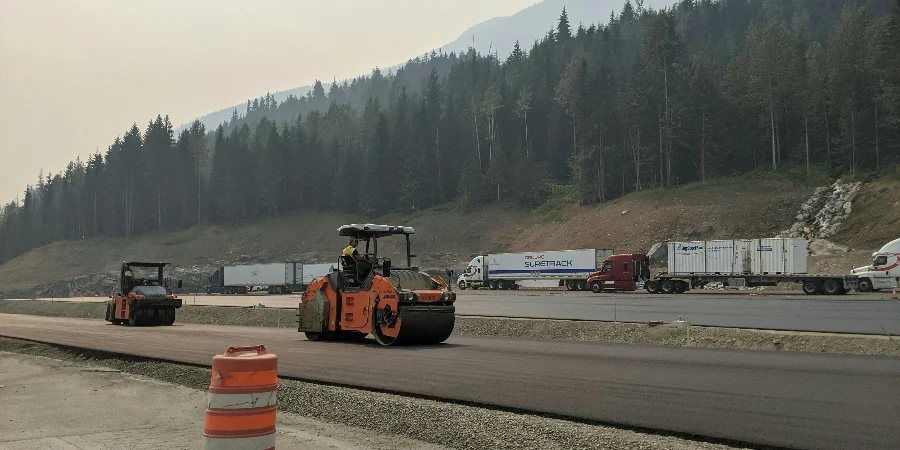في عام 2025، سيشهد سوق بكرات الطرق ازدهارًا كبيرًا بفضل الابتكارات في بكرات الطرق الذكية والآلية. تتعمق هذه المقالة في الأنواع ومقاييس الأداء والتكنولوجيا المتطورة، مما يوفر للمشترين المحترفين معلومات أساسية لاتخاذ قرارات مستنيرة. تعرف على كيفية تعزيز هذه التطورات للكفاءة التشغيلية وتلبية متطلبات مشاريع البنية التحتية الحديثة.
جدول المحتويات:
-نظرة عامة على سوق أسطوانات الطرق
-تحليل متعمق لسوق أسطوانات الطرق
-العوامل الرئيسية عند اختيار أسطوانة الطرق
-التكنولوجيا المتقدمة في مداحل الطرق
- اعتبارات التكلفة والميزانية
-اتجاهات الصناعة والتطورات المستقبلية
-الختام
نظرة عامة على سوق أسطوانات الطرق
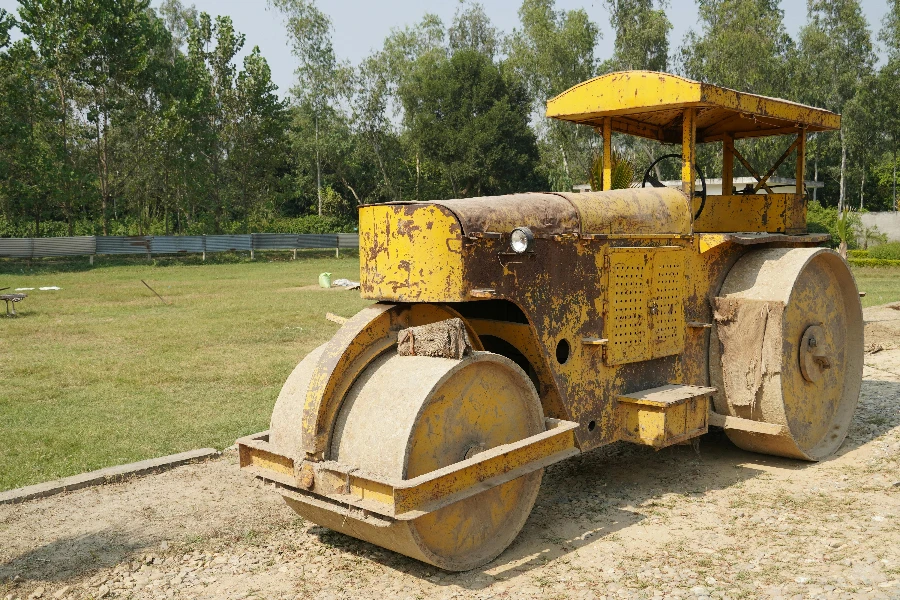
شهد سوق مدحلات الطرق العالمية نموًا كبيرًا في السنوات الأخيرة، مدفوعًا بمشاريع البنية التحتية والتوسع الحضري. في عام 2024، قُدِّرت قيمة السوق بنحو 4.5 مليار دولار أمريكي، مع توقعات بأن تصل إلى 6.7 مليار دولار أمريكي بحلول عام 2030، بمعدل نمو سنوي مركب قدره 6.5%. ويرجع هذا النمو بشكل أساسي إلى الاستثمارات الحكومية في بناء الطرق وصيانتها، وخاصة في الاقتصادات الناشئة التي تعطي الأولوية للبنية التحتية الحضرية.
تتمتع منطقة آسيا والمحيط الهادئ بأكبر حصة سوقية، بأكثر من 40%، وذلك بسبب التوسعات الواسعة النطاق لشبكات الطرق في دول مثل الصين والهند. كما تشهد أمريكا الشمالية وأوروبا نموًا، مدفوعًا بالحاجة إلى تجديد وصيانة البنية التحتية للطرق الحالية. كما يعمل تبني التقنيات المتقدمة في معدات بناء الطرق، مثل المدحلات الذكية والآلية، على تعزيز نمو السوق.
يتم تقسيم السوق حسب النوع إلى بكرات ثابتة واهتزازية، حيث تحتل البكرات الاهتزازية أكثر من 60% من حصة السوق بسبب كفاءتها في ضغط أنواع مختلفة من التربة. هذه البكرات مطلوبة بشدة لمشاريع البناء واسعة النطاق. يتم تقسيم السوق أيضًا حسب التطبيق إلى بناء سكني وتجاري وصناعي، مع احتلال القطاع التجاري الصدارة بسبب الاستخدام المكثف في مشاريع البنية التحتية الكبيرة.
تحليل متعمق لسوق أسطوانات الطرق
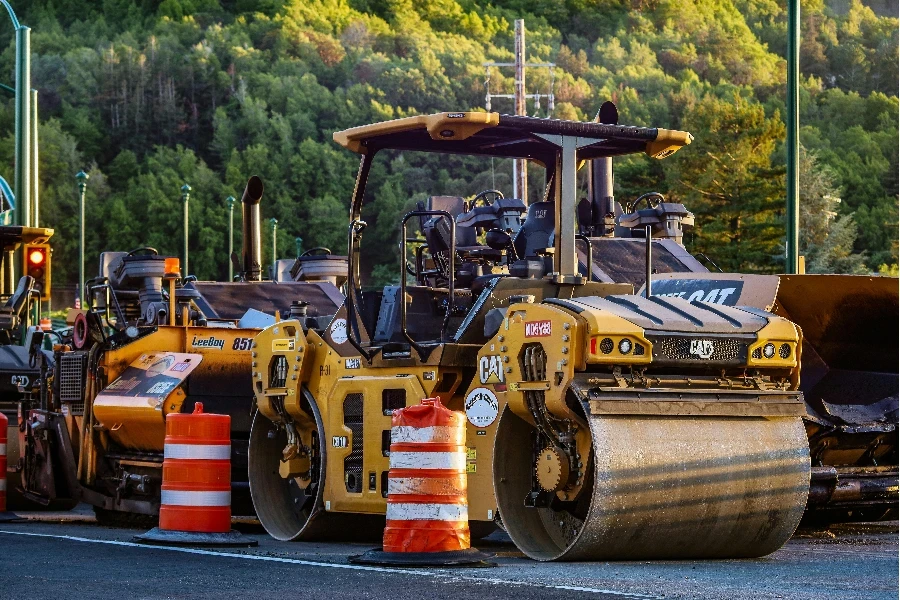
إن سوق مداحل الطرق ديناميكي، حيث تمتلك شركات رئيسية مثل Caterpillar Inc. وBOMAG وVolvo Construction Equipment حصصًا كبيرة بسبب عروض المنتجات الواسعة وشبكات التوزيع الخاصة بها. يؤثر الإنفاق الحكومي على البنية الأساسية بشكل مباشر على السوق، حيث تؤدي زيادة الميزانيات إلى زيادة الطلب على مداحل الطرق.
يتحول سلوك المستهلك نحو الآلات المتقدمة تكنولوجياً والموفرة للوقود، مدفوعًا بالحاجة إلى حلول فعّالة من حيث التكلفة وصديقة للبيئة. تتطور قنوات التوزيع، مع تفضيل متزايد للمبيعات المباشرة والمنصات عبر الإنترنت، مما يسمح للمصنعين بالوصول إلى قاعدة عملاء أوسع بكفاءة.
تتضمن الابتكارات الحديثة مداحل الطرق الهجينة والكهربائية بالكامل، والتي اكتسبت زخمًا بسبب انخفاض التأثير البيئي وتكاليف التشغيل. هذه التطورات مهمة في المناطق التي تفرض لوائح صارمة للانبعاثات. تشير دورة حياة منتج مداحل الطرق إلى مرحلة النضج، مع التحسينات المستمرة لتعزيز الأداء والكفاءة.
إن التحول الرقمي أمر بالغ الأهمية، حيث يتيح دمج إنترنت الأشياء والاتصالات عن بعد في مداحل الطرق إمكانية المراقبة في الوقت الفعلي والصيانة التنبؤية وتحسين التشغيل، مما يقلل من وقت التوقف عن العمل وتكاليف الصيانة. كما تؤثر الاتجاهات الاجتماعية، مثل التركيز المتزايد على ممارسات البناء المستدامة، على ديناميكيات السوق.
تشمل نقاط الضعف لدى العملاء تكاليف الاستثمار الأولية المرتفعة والحاجة إلى مشغلين مهرة. ويعالج المصنعون هذه التحديات من خلال تقديم خيارات التمويل وبرامج التدريب. ويركز وضع العلامة التجارية على الموثوقية والابتكار التكنولوجي ودعم ما بعد البيع للتمييز بين المنتجات في سوق تنافسية. وتستهدف الأسواق المتخصصة، مثل المشاريع الحضرية الصغيرة الحجم واحتياجات الضغط المتخصصة، نماذج مدحلة طرق مدمجة ومتعددة الاستخدامات.
العوامل الرئيسية عند اختيار أسطوانة الطرق
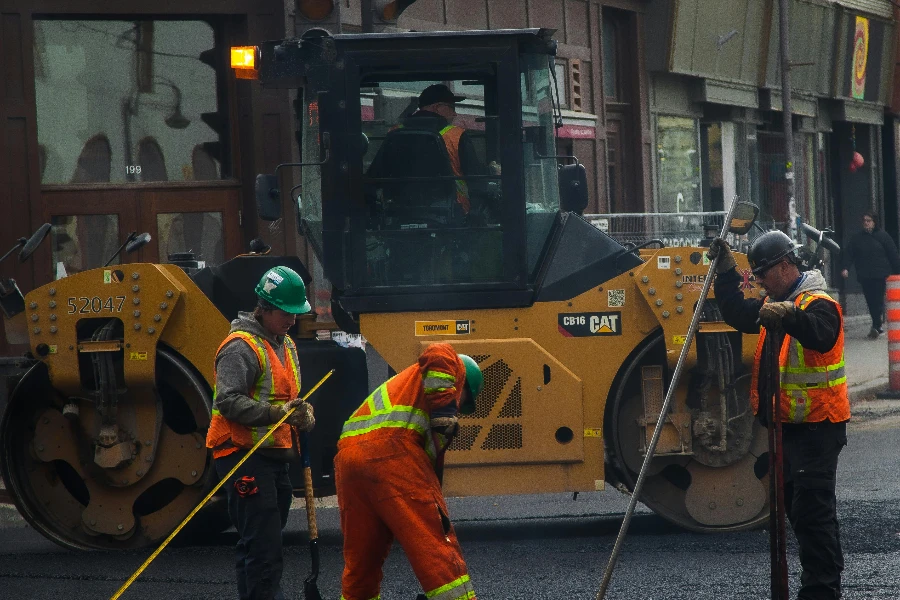
عند اختيار مدحلة الطرق، يجب مراعاة عوامل مختلفة لضمان الأداء الأمثل والملاءمة لتطبيقات معينة. تتضمن هذه العوامل أنواع مدحلات الطرق والأداء والوظائف والمواصفات الفنية وجودة التصنيع والمواد ومعايير السلامة والشهادات.
أنواع بكرات الطرق
تتوفر مداحل الطرق بأنواع مختلفة، كل منها مصمم لمهام وبيئات محددة. تشمل الأنواع الأساسية المداحل الثابتة والمداحل الاهتزازية والمداحل الهوائية.
تعتمد الأسطوانات الثابتة على وزن الآلة لضغط المواد. وهي مناسبة لضغط المواد الحبيبية وغالبًا ما تُستخدم في المشاريع التي لا تتطلب قوة ضغط عالية. تشتهر هذه الأسطوانات ببساطتها وسهولة صيانتها.
تستخدم الأسطوانات الاهتزازية الاهتزازات لتعزيز كفاءة الضغط. وهي مجهزة بآلية اهتزازية تنتج تذبذبات، مما يسمح بضغط أعمق وأكثر اتساقًا. تعد الأسطوانات الاهتزازية مثالية لضغط الأسفلت والمواد المتماسكة الأخرى. وهي تأتي في تكوينات ذات أسطوانة واحدة وأسطوانتين، مما يوفر المرونة لتطبيقات مختلفة.
تستخدم الأسطوانات الهوائية، المعروفة أيضًا باسم الأسطوانات ذات الإطارات المطاطية، سلسلة من الإطارات المطاطية لتحقيق الضغط. توفر الإطارات عملية عجن تساعد في تحقيق سطح أملس. تُستخدم الأسطوانات الهوائية عادةً في تشطيب الأسفلت وتُقدَّر لقدرتها على ضغط الأسفلت والمواد الحبيبية بشكل فعال.
الأداء والوظيفة
يعد أداء ووظائف مدحلة الطرق من الاعتبارات المهمة في عملية الاختيار. وتتضمن مقاييس الأداء الرئيسية قوة الضغط والسرعة والقدرة على المناورة.
تقيس قوة الضغط الضغط الذي تمارسه الأسطوانة على المادة التي يتم ضغطها. وتؤدي قوة الضغط الأعلى إلى زيادة كثافة المادة واستقرارها. وتسمح أسطوانات الطرق ذات إعدادات قوة الضغط القابلة للتعديل للمشغلين بتخصيص الضغط بناءً على متطلبات المادة والمشروع.
تؤثر السرعة على كفاءة وإنتاجية عملية الضغط. تم تجهيز مداحل الطرق الحديثة بإعدادات سرعة متغيرة، مما يتيح للمشغلين ضبط سرعة الدحرجة لتتناسب مع احتياجات الضغط. تعد المداحل عالية السرعة مناسبة للمشاريع الكبيرة، في حين تعد المداحل منخفضة السرعة مثالية للأعمال الدقيقة.
تعد القدرة على المناورة أمرًا ضروريًا للتنقل في المساحات الضيقة ومواقع المشاريع المعقدة. توفر مداحل الطرق ذات التوجيه المفصل والتصميمات المدمجة قدرة فائقة على المناورة، مما يسمح للمشغلين بتحقيق ضغط ثابت في البيئات الصعبة. تعمل الميزات مثل التوجيه المعزز وأنظمة التحكم المتقدمة على تعزيز راحة المشغل وسهولة الاستخدام.
بيانات المعدة
إن فهم المواصفات الفنية للمدحلة أمر بالغ الأهمية لاتخاذ قرار مستنير. تتضمن المواصفات الرئيسية عرض الأسطوانة وقطر الأسطوانة وقوة المحرك.
يحدد عرض الأسطوانة مساحة تغطية الأسطوانة. تغطي الأسطوانة الأعرض مساحة أكبر في تمريرة واحدة، مما يزيد من الإنتاجية. ومع ذلك، قد تكون أقل ملاءمة للمساحات الضيقة أو المحصورة. من الضروري اختيار عرض الأسطوانة الذي يوازن بين التغطية والقدرة على المناورة بناءً على متطلبات المشروع.
يؤثر قطر الأسطوانة على عمق الضغط. توفر أقطار الأسطوانة الأكبر ضغطًا أعمق، مما يجعلها مناسبة للطبقات السميكة من المواد. وعلى العكس من ذلك، فإن أقطار الأسطوانة الأصغر تكون أفضل لمهام ضغط السطح والتشطيب. يضمن اختيار قطر الأسطوانة المناسب عمق ضغط مثالي وجودة سطح.
قوة المحرك هي عامل حاسم يؤثر على الأداء العام للمدحلة. توفر قوة المحرك العالية عزم الدوران والسرعة اللازمين للضغط الفعال. تم تجهيز مدحلات الطرق الحديثة بمحركات موفرة للوقود تتوافق مع معايير الانبعاثات، مما يضمن الاستدامة البيئية وتوفير التكاليف.
بناء الجودة والمواد
تؤثر جودة البناء والمواد المستخدمة في تصنيع بكرات الطرق بشكل كبير على متانتها وطول عمرها. تضمن المواد عالية الجودة والبناء القوي أداءً موثوقًا به وتكاليف صيانة منخفضة.
يجب أن يكون هيكل وجسم الأسطوانة مصنوعين من فولاذ عالي القوة أو مواد متينة أخرى يمكنها تحمل قسوة الاستخدام الشاق. تعمل الطلاءات واللمسات النهائية المقاومة للتآكل على حماية الآلة من العوامل البيئية، مما يطيل عمرها الافتراضي.
يعد سطح الأسطوانة مكونًا مهمًا آخر يتطلب الاهتمام. يجب أن تكون الأسطوانة مصنوعة من مواد مقاومة للتآكل مثل الفولاذ المقوى لمنع التلف وضمان جودة ضغط ثابتة. بالإضافة إلى ذلك، يجب أن يكون سطح الأسطوانة أملسًا وخاليًا من العيوب لتحقيق تشطيب موحد.
معايير وشهادات السلامة
السلامة هي الأهم في تشغيل مداحل الطرق. الالتزام بمعايير السلامة والشهادات يضمن سلامة المشغلين والامتثال للمتطلبات التنظيمية.
يجب أن تكون مداحل الطرق مجهزة بخصائص أمان مثل هياكل الحماية من الانقلاب (ROPS) وأحزمة الأمان وأزرار التوقف في حالات الطوارئ. تعمل هذه الخصائص على حماية المشغلين في حالة وقوع حادث وتقليل مخاطر الإصابة.
تشير الشهادات الصادرة عن المنظمات المعترف بها، مثل ISO وOSHA، إلى أن الأسطوانة تلبي معايير السلامة والأداء الصارمة. يجب على الشركات المصنعة تقديم وثائق تثبت امتثالها للشهادات ذات الصلة لضمان جودة وسلامة الآلة للمشترين.
التكنولوجيا المتقدمة في مداحل الطرق
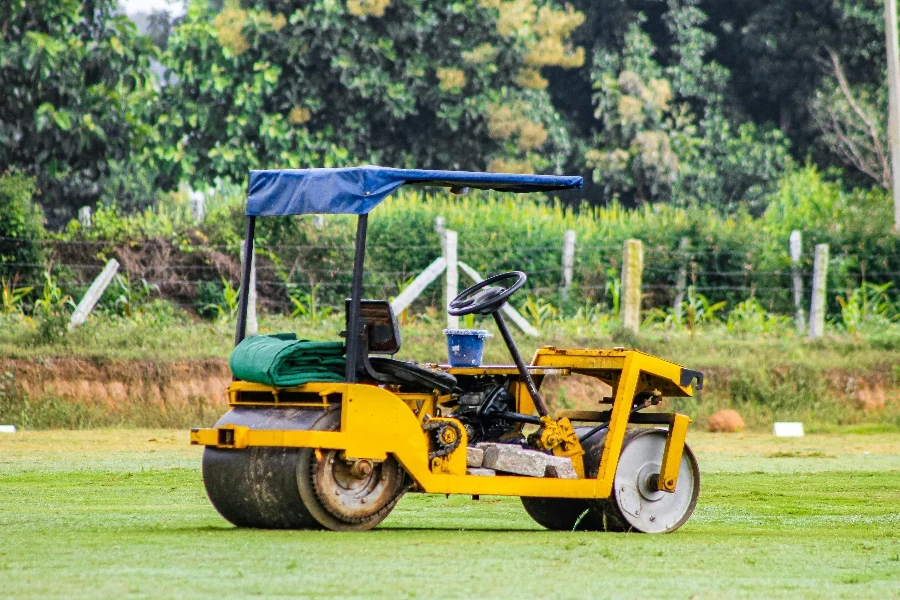
لقد أدى دمج التكنولوجيا المتقدمة في مداحل الطرق إلى إحداث ثورة في صناعة البناء، مما أدى إلى تعزيز الكفاءة والدقة وسهولة الاستخدام.
أنظمة الضغط الذكية
تُعد أنظمة الضغط الذكية تقدمًا تقنيًا كبيرًا في مداحل الطرق. تستخدم أنظمة الضغط الذكية البيانات وأجهزة الاستشعار في الوقت الفعلي لمراقبة عملية الضغط والتحكم فيها. توفر هذه الأنظمة للمشغلين ملاحظات حول صلابة المادة وتوحيد الضغط وسمك الطبقة، مما يتيح إجراء تعديلات دقيقة للحصول على نتائج مثالية.
كما توفر أنظمة IC ميزات مثل رسم الخرائط باستخدام نظام تحديد المواقع العالمي (GPS) وتسجيل البيانات، مما يسمح لمديري المشاريع بتتبع تقدم عملية الضغط وضمان الامتثال لمواصفات المشروع. يقلل استخدام أنظمة IC من خطر الإفراط في الضغط أو نقص الضغط، مما يؤدي إلى تحسين أداء المواد وإطالة عمر الأرصفة.
التليماتية والرصد عن بعد
تتيح تقنية الاتصالات عن بعد مراقبة وإدارة مداحل الطرق عن بعد. تجمع أنظمة الاتصالات عن بعد وتنقل البيانات حول أداء الماكينة وموقعها واستهلاك الوقود واحتياجات الصيانة. يمكن الوصول إلى هذه المعلومات من خلال منصات تعتمد على الويب، مما يسمح لمديري الأسطول بمراقبة العديد من الماكينات من موقع مركزي.
تعمل المراقبة عن بعد على تعزيز الكفاءة التشغيلية من خلال تمكين الصيانة الاستباقية، وتقليل وقت التوقف عن العمل، وتحسين تخصيص الموارد. كما توفر الاتصالات عن بعد رؤى حول سلوك المشغل واستخدام الآلة، مما يساعد في تحديد مجالات التحسين والتدريب.
الأتمتة والتشغيل الذاتي
تعد الأتمتة والتشغيل الذاتي من الاتجاهات الناشئة في صناعة مداحل الطرق. تستخدم مداحل الطرق ذاتية التشغيل أجهزة استشعار متقدمة ونظام تحديد المواقع العالمي والذكاء الاصطناعي لأداء مهام الضغط دون تدخل بشري. يمكن لهذه الآلات التنقل في مواقع المشاريع المعقدة وتجنب العوائق وتحقيق أنماط ضغط دقيقة.
تقلل الأتمتة من الاعتماد على العمالة الماهرة وتقلل من الخطأ البشري، مما يؤدي إلى ضغط متسق وعالي الجودة. وفي حين لا تزال مداحل الطرق ذاتية التشغيل بالكامل في المراحل الأولى من التطوير، فإن الميزات شبه المستقلة مثل التوجيه التلقائي والتحكم في السرعة متاحة بالفعل في مداحل الطرق الحديثة.
اعتبارات التكلفة والميزانية
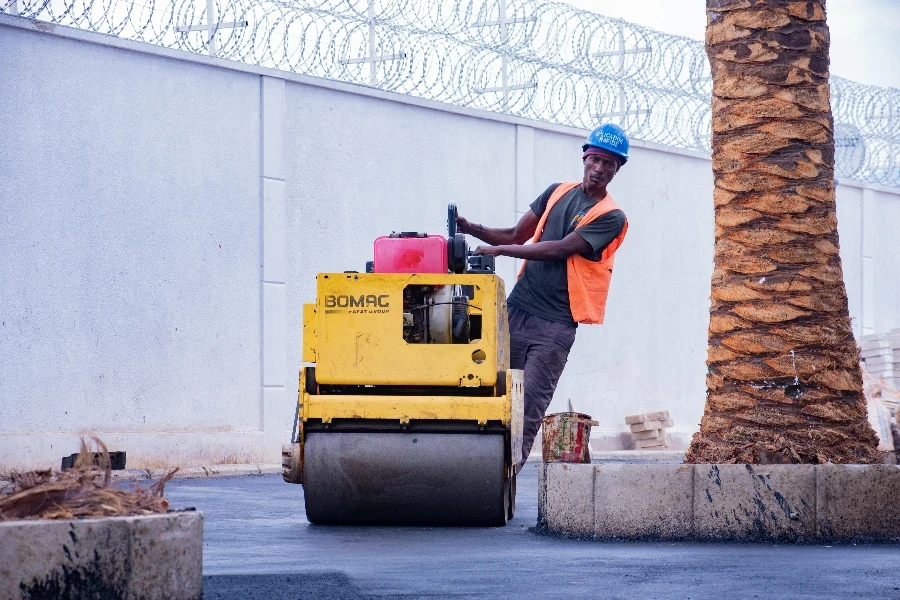
تعتبر الاعتبارات المتعلقة بالتكلفة والميزانية من الجوانب الأساسية في عملية اختيار الأسطوانة. يجب على المشترين تقييم التكلفة الإجمالية للملكية، بما في ذلك سعر الشراء وتكاليف التشغيل ونفقات الصيانة وقيمة إعادة البيع.
سعر الشراء وخيارات التمويل
يختلف سعر شراء مدحلة الطرق بناءً على عوامل مثل النوع والحجم والميزات المتقدمة. يجب على المشترين مقارنة الأسعار من العديد من الشركات المصنعة والنظر في القيمة التي تقدمها كل آلة. في حين أن الطرز الأعلى سعرًا قد تكون تكلفتها الأولية أعلى، إلا أنها غالبًا ما توفر أداءً ومتانة وميزات متقدمة أفضل.
توفر خيارات التمويل، مثل برامج التأجير والاستئجار، المرونة للمشترين الذين لديهم قيود الميزانية. يسمح التأجير للمشترين باستخدام المعدات لفترة محددة مع دفعات شهرية أقل، في حين توفر برامج التأجير إمكانية الوصول قصير الأجل إلى مداحل الطرق لمشاريع محددة.
تكاليف التشغيل والصيانة
تتضمن تكاليف التشغيل استهلاك الوقود والعمالة والصيانة الدورية. تعمل مداحل الطرق الموفرة للوقود والمزودة بتقنية محرك متقدمة على تقليل نفقات الوقود وتقليل التأثير البيئي. تضمن الصيانة الدورية، مثل تغيير الزيت واستبدال الفلاتر والفحوصات، الأداء الأمثل وتمنع الأعطال المكلفة.
يمكن إدارة تكاليف الصيانة من خلال عقود الخدمة والضمانات الممتدة التي تقدمها الشركات المصنعة. تغطي هذه العقود الصيانة والإصلاحات المجدولة، مما يوفر راحة البال والنفقات المتوقعة.
قيمة إعادة البيع والإهلاك
تتأثر قيمة إعادة بيع مدحلة الطرق بعوامل مثل سمعة العلامة التجارية والعمر والحالة والطلب في السوق. مدحلة الطرق التي يتم صيانتها جيدًا من الشركات المصنعة ذات السمعة الطيبة تحتفظ بقيمتها بشكل أفضل وتقدم أسعار إعادة بيع أعلى.
يعد الاستهلاك من الاعتبارات المهمة، حيث يؤثر على تكلفة الملكية على المدى الطويل. يجب على المشترين اختيار مداحل الطرق ذات معدلات الاستهلاك المنخفضة لتعظيم استثماراتهم. يمكن أن يؤدي الاحتفاظ بسجلات صيانة مفصلة والالتزام بتوصيات الشركة المصنعة إلى تعزيز قيمة إعادة بيع الآلة.
اتجاهات الصناعة والتطورات المستقبلية
تتطور صناعة مداحل الطرق باستمرار، مع وجود اتجاهات وتطورات جديدة تشكل مستقبل تكنولوجيا الضغط.
حلول مستدامة وصديقة للبيئة
تُعَد الاستدامة محور تركيز متزايد في صناعة البناء، ويتبنى مصنعو مداحل الطرق حلولاً صديقة للبيئة للحد من التأثير البيئي. ويتم تطوير مداحل الطرق الكهربائية والهجينة لتقليل الانبعاثات واستهلاك الوقود. توفر هذه الآلات تشغيلًا هادئًا وهي مناسبة للمشاريع الحضرية ذات اللوائح الصارمة المتعلقة بالضوضاء والانبعاثات.
كما يتم تنفيذ المواد القابلة لإعادة التدوير وممارسات التصنيع المستدامة لتقليل البصمة الكربونية لإنتاج بكرات الطرق. يجب على المشترين النظر في الخيارات الصديقة للبيئة لتتماشى مع أهداف الاستدامة والامتثال للوائح البيئية.
تكامل الذكاء الاصطناعي وتعلم الآلة
تعمل الذكاء الاصطناعي والتعلم الآلي على تحويل قدرات مداحل الطرق. حيث تقوم خوارزميات الذكاء الاصطناعي بتحليل البيانات من أجهزة الاستشعار وأنظمة الضغط الذكية لتحسين معلمات الضغط والتنبؤ باحتياجات الصيانة. كما يتيح التعلم الآلي لمداحل الطرق التعلم من المشاريع السابقة وتحسين الأداء بمرور الوقت.
إن دمج الذكاء الاصطناعي والتعلم الآلي يعزز عملية اتخاذ القرار، ويقلل من تكاليف التشغيل، ويحسن جودة الضغط. ومع استمرار تقدم هذه التقنيات، ستصبح مداحل الطرق أكثر ذكاءً وكفاءة، مما يوفر إمكانيات جديدة لصناعة البناء.
التدريب والدعم المعزز للمشغل
يعد تدريب المشغلين ودعمهم أمرًا بالغ الأهمية لتحسين أداء وسلامة بكرات الطرق. يعمل المصنعون على تطوير برامج تدريبية متقدمة تستخدم الواقع الافتراضي والواقع المعزز لتوفير تجارب تعليمية غامرة وتفاعلية. تحاكي هذه البرامج سيناريوهات العالم الحقيقي، مما يسمح للمشغلين بالتدرب وصقل مهاراتهم في بيئة آمنة.
كما يتم تعزيز الدعم الفني والمساعدة عن بعد من خلال المنصات الرقمية والتطبيقات المحمولة. ويمكن للمشغلين الوصول إلى أدلة استكشاف الأخطاء وإصلاحها، وتعليمات الصيانة، والدعم في الوقت الفعلي من خبراء الشركة المصنعة، مما يضمن التشغيل السلس والفعال لمدحلات الطرق.
في المخص:
باختصار، يتطلب اختيار الأسطوانة المناسبة دراسة متأنية لعوامل مختلفة، بما في ذلك الأنواع والأداء والمواصفات الفنية وجودة التصنيع ومعايير السلامة. كما تؤثر التكنولوجيا المتقدمة واعتبارات التكلفة واتجاهات الصناعة بشكل أكبر على عملية اتخاذ القرار. ومن خلال تقييم هذه الجوانب، يمكن للمشترين اختيار الأسطوانة التي تلبي احتياجاتهم المحددة وتساهم في نجاح مشاريع البناء.
